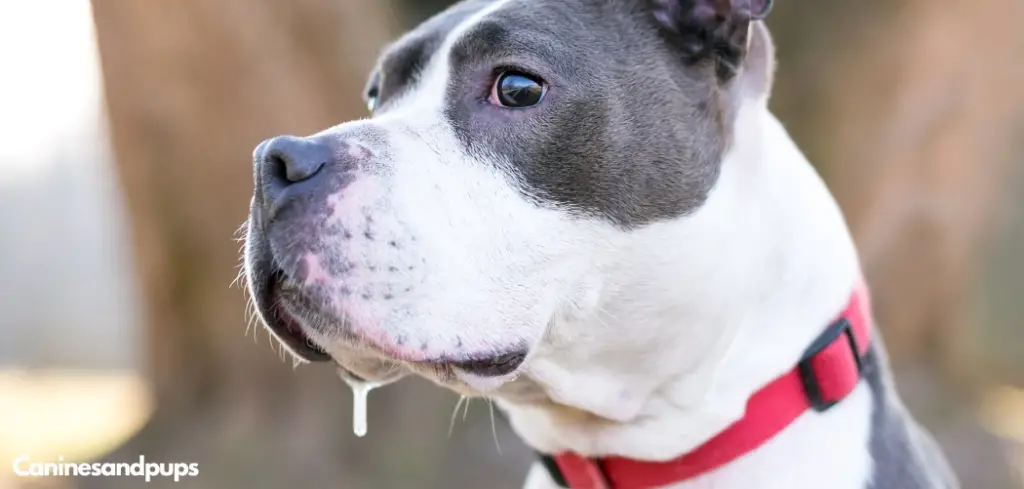It’s alarming to see your dog drooling more than usual, especially if the saliva seems to pour from their mouth or drip constantly.
While some drool is normal, excessive salivation—also called ptyalism—can indicate an underlying issue.
We outline the common causes of a dog excessively salivating, what you can do at home, and when to seek veterinary help.
Table of Contents
Dog Excessively Salivating — Why It Happens
Excessive drooling in dogs can result from oral pain, nausea, anxiety, toxins, or underlying diseases. Dental infections or foreign objects lodged in the mouth can trigger extra salivation.
Dogs who feel nauseated or are about to vomit may also drool heavily. Emotional stress or fear can cause panting and salivation, particularly during thunderstorms or car rides.
In more serious cases, toxic exposure, liver disease, or neurological disorders may be to blame.

Dog Excessively Salivating: Common Causes
Dental Disease
Dental problems are one of the most common causes of excessive salivation in dogs.
When a dog has gingivitis, broken teeth, or an abscess, the irritation in their mouth can lead to constant drooling.
You may notice foul breath, difficulty chewing, pawing at the mouth, or visible tartar.
Pain in the gums or around the teeth can cause your dog to drool continuously, especially when eating or trying to chew.
In advanced cases, untreated dental infections can lead to systemic illness, so early diagnosis is crucial.
Read more: Dog panting excessively (What’s causing it?)
Nausea and Gastrointestinal Upset
When dogs feel nauseated, they often begin drooling excessively.
This can be a precursor to vomiting or a sign of motion sickness. Some dogs drool in the car before they ever vomit.
Nausea can stem from many issues, including dietary indiscretion, stomach infections, or more serious conditions like pancreatitis.
Look for other signs like lip licking, restlessness, or a refusal to eat. If diarrhea or vomiting follows, GI illness may be the cause.
Foreign Object in the Mouth
A stick, bone shard, or toy part can get stuck in your dog’s mouth or throat and cause intense salivation.
If your dog is drooling, pawing at the mouth, or struggling to close it properly, inspect their mouth carefully (if safe to do so).
Dogs may try to rub their faces on the ground or appear panicked.
Objects wedged between teeth, under the tongue, or in the throat should be removed promptly by a vet to prevent injury.
Anxiety or Stress
Emotional triggers like fear, stress, or overstimulation can lead to drooling.
Dogs with separation anxiety, phobias (like thunderstorms), or stress from unfamiliar environments may drool more than usual.
This type of salivation often occurs alongside other behaviors like pacing, panting, shaking, and clinginess.
Although less dangerous than medical causes, chronic anxiety can degrade quality of life and may require behavior modification or medication.
Toxic Exposure
Some toxins cause excessive salivation almost immediately after ingestion.
This includes plants like sago palm, household cleaners, slug bait, or even toads in some regions.
If your dog suddenly begins drooling, especially with vomiting, tremors, or lethargy, suspect poisoning and seek urgent care.
Other signs may include dilated pupils, foaming at the mouth, seizures, or collapse, depending on the substance involved.
Liver or Kidney Disease
Diseases that affect the liver or kidneys can lead to nausea and toxin buildup in the blood, which in turn causes excessive drooling.
Chronic kidney disease or liver failure may cause intermittent or constant ptyalism.
Owners may notice weight loss, increased thirst, vomiting, or foul-smelling breath.
These conditions are serious and require veterinary intervention to manage symptoms and prolong life.
What to Do If Your Dog Is Excessively Salivating
Start by observing your dog calmly and checking their mouth for obvious problems.
If your dog allows, gently open their mouth and look for foreign objects, cuts, or swollen gums. Be cautious—pain may cause them to react defensively.
Offer fresh water and monitor for signs of nausea or vomiting. If your dog is drooling in a car or during thunderstorms, try to remove the trigger or use calming techniques.
Avoid giving human medications. If your dog is otherwise acting normal and the drooling resolves within a few hours, it may have been a minor irritant.
However, if drooling persists or other symptoms appear, call your vet.
When to Call or Visit Your Vet
Contact your vet promptly if you notice any of the following:
Sudden, severe drooling without explanation
Signs of pain or difficulty swallowing
Vomiting, diarrhea, or lethargy
Facial swelling or bleeding from the mouth
Ingestion of a known toxin
If your dog’s excessive salivation continues for more than a few hours or worsens, a medical issue may be the root cause.
Prompt treatment can prevent complications and provide relief for your dog.
Read more: Dog licking air excessively (When to worry and what to do)
Key Takeaway
Excessive drooling in dogs can be distressing to witness, especially if it comes on suddenly or is accompanied by other symptoms.
Check your dog’s mouth, watch for signs of nausea or toxin exposure, and remove any environmental triggers you can.
When in doubt, a veterinary visit is the best way to rule out serious causes and get your pup feeling better.
Your dog’s comfort and safety come first—trust your instincts and act quickly if something feels off.
